
Strong and supple pelvic floor muscles are essential to our good health, wellbeing and continued enjoyment of great sex, urinary and fecal continence, core stability and even good breathing technique. Since the YouTube release of “CrossFit -Do You Pee During Workouts?” the issue of stress urinary incontinence (SUI) has become a hot topic. While the ignorance of the professionals on the video is shockingly sad, opening up this conversation is a good thing. Peeing during workouts, laughing, coughing, running is not normal! There is help!
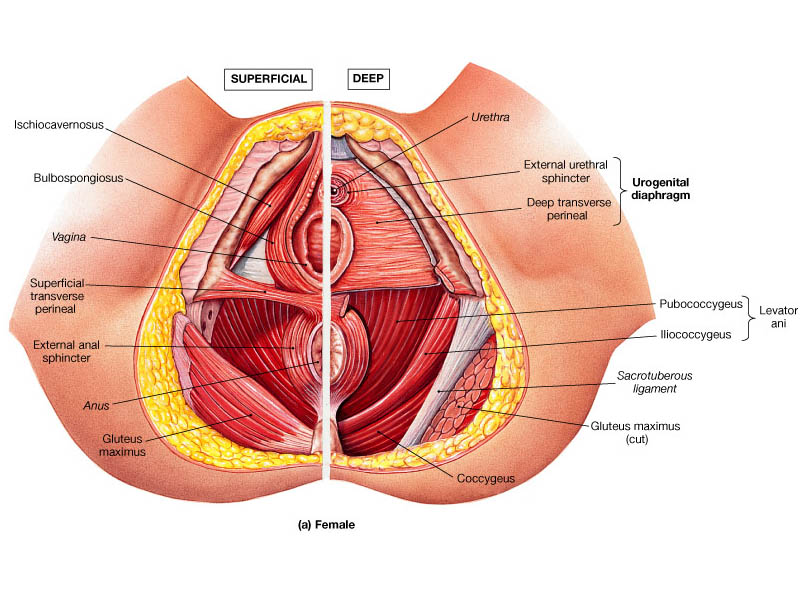
The pelvic floor is formed primarily by two sets of muscles – the levator ani and the coccygeus, and together they form the funnel-shaped pelvic diaphragm – the base of our core cylinder. The levator ani is comprised of three muscles – the puborectalis, pubococcygeus and the iliococcygeus – their names telling us where they are located within the pelvis. The puborectalis attaches at the pubis to each side of the pubic symphysis and slings around the rectum. The pubococcygeus reaches from the pubis, anterior to the obturator canal, and the anterior portion of the tendinous arch on the ischium, and then surrounds the rectum and attaches to the anococcygeal raphe and the lateral coccyx. The iliococcygeus originates from the posterior tendinous arch, obturator internus fascia and ischial spine, and attaches at the anococcygeal raphe and coccyx. And finally, the coccygeus is situated posteriorly to the levator ani and attaches on the ischial spine and the sacrospinous ligament and reaches back to attach to the lateral part of the lower sacrum and upper coccyx.
The pelvic diaphragm lies deep to the superficial perineum. The perineum is the diamond shaped area framed by the pubic symphysis, the ischial tuberosities and the coccyx. Here the small muscles associated with the orifices of the pelvic organs – sphincters of the urethra and anus, and muscles of the vaginal opening are fixed within the double-layered perineal membrane, as is the clitoris. A line drawn between the ischial tuberosities divides the area into the urogenital triangle anteriorly and the anal triangle posteriorly. This distinction becomes important when trying to isolate and exercise the different areas of the pelvic floor musculature.
The main functions of the pelvic diaphragm are:
1 – providing physical support for and securing the positions of the lower abdominal organs – bladder, uterus or prostate, and rectum.
2 – continence – having both voluntary and involuntary mechanisms for the contraction of muscles involved in starting or stopping urination, tightening the vagina or maintaining penile erection, and contracting the anal sphincter.
3 – supporting respiration – responding to and moving with the respiratory diaphragm, regulating the pressure of intra-abdominal fluid, and directly affecting the quality and fullness of the breath
4 –core stability–working together with the transverse abdominis, respiratory diaphragm and multifidi, the pelvic diaphragm provides constant support and stability to the pelvis not only as we move, but in preparation for any movement, including simple arm movements.
To successfully perform the above functions, the pelvic diaphragm must be able to alternate between strong and activated, and relaxed and supple. This balance between muscular tonicity and elasticity is a functional requirement sadly lacking in too many bodies.
So, that’s the pelvic diaphragm anatomy lesson. Tune in to Part 2 for some great YogaTune Up® techniques and exercises that will strengthen your pelvic floor muscles to embody this strong and supple balance.
Discover how to get strong and supple pelvic muscles.



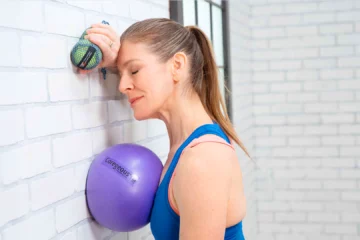
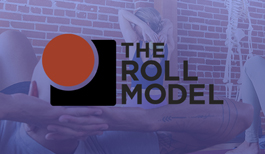



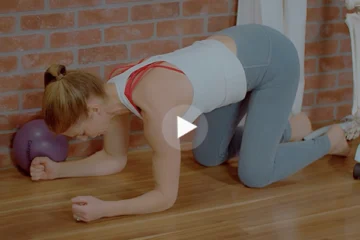
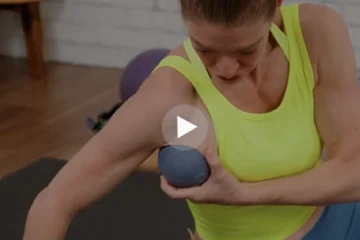


At age 50, and 8 years after an emergency c-section/traumatic birth, I finally had an appointment last month with a pelvic floor specialist. During our initial conversation she told me that in France (and some other European countries), post natal care for women includes 12 pelvic floor health appointments! Incredible!
The pelvic floor is many layered not just anatomically but also emotionally. For many women, past trauma either from birth or other experiences can affect our ability to sense and feel what is happening in this part of our bodies. Healthy breath patterns are affected by the elasticity and buoyancy of the pelvic floor tissues, and moving about daily life and placing a heavier demand on our bodies during exercise should be able to be supported by healthy pelvic floor functioning. Incontinence is no fun anytime! Thank you for the anatomical explanations outlined in this article as well as the clear list of the many functions of the pelvic floor.
Great anatomical instruction. I need to go find part two now!
Women are too often unaware of the importance of this muscle. In my group classes, I often hear that women train with a sanitary napkin. We need to educate our students about this. Post-natal fitness should, in my opinion, be focused on this area of the body first and foremost.
It is sad but true to see so many woman thinking it’s normal to have leaks when they laught, run, jump or whenever they are out of breath. Hope to interact with lots of them and educate them on what’s really normal.
I’m always so surprised by the number of women that have pelvis floor issues, and they don’t even realize there can be a better way to live. Thank you for the deep dive into a complex area of the female body. Greatly appreciated.
thanks for the journey through the multi layered pelvic floor muscles. Seeing is believing as helps practically when visualizing a strong Pelvic Floor.
Women should learn this part of their bodies at puberty and avoid problems related to delivery and aging.
I am so glad that light is being shed on this topic. Peeing during a work out is not ok and could lead to even more muscular imbalances and problems in the future if the pelvic floor is continually stressed during workouts or every day activities. Also, don’t forget about obterator internus. A very important hip stabilizer and rotator that commonly leads to hip pain and pain with intercourse when short and weak.
I have had a pelvic floor issues since I can remember. As a child I was in and out of the doctors office for a number of years with no answers. This article has given me information to develop some exercises to integrate into my practice and my teachings so that I can empower myself by understanding and embodying those areas that it is connected to and works cooperatively with.
I feel like I have had a pelvic floor issue since I can remember. As a child I went to the doctor, I can’t count how many times, about not being able to control my bladder. I went through test upon test trying to figure out what was wrong and in the end they told my parents that I just held it too long because I didn’t want to miss anything that happened when I was in the bathroom. I had this problem until I was about 13. I was an active kid. I figure skated competitively so my core was strong. So it didn’t make sense. Now I am a professional dancer. I am in better shape than I have ever been and its back. I was jumping on a trampoline. Walking around at work. At first I thought I had a urinary tract infection or a bladder infection. But no. This blog has given me information to take the matter into my own hands to develop my own tools of self-care, and maybe help others that secretly may have the same issues but are too shy to ask for help.
The many functions of the pelvic floor never cease to amaze me – especially since it’s an area of the body that so many can’t even access to contract and relax voluntarily!
I am working on finding what it is exactly causing a particular beginning pain, as we know it can be such a braid ranger of things near, or not near that actual area. I love learning more about pelvic floor release as I hold so much trauma there and want to release it.
This was a great anatomy lesson for me – thank you. Having had two very tough vaginal births – I did go to pelvic floor physio which helped immensely but had a hard time envisioning what she was talking about. This is one area every new mother should be educated in and receive therapy for. You don’t have to have a rough birth to need a bit of help ‘down there’ – you pushed a large object through a small hole! Knowing how to help strengthen it again is so important for post partum quality of life. Can’t wait to read about the exercises!!
Not enough attention is given to this area and its extreme importance. I was happy to see and read it and look forward to part 2 to incorporate exercise with knowledge.
What about scar tissue following childbirth and if stitching resulted in misalignment of tissues and underlying muscles? I guess there will be compensation somewhere. Of course, exercices should help anyways.
Great breakdown of the pelvic floor muscles, pelvic floor dysfunction affects so many women I know, and I try to explain to them they don’t have to accept urinary incontinence!
Good anatomy lesson all around. I learned more about the function of the pelvic floor.
Very informative article that I can share with my clients.
I’m working with a Pelvic Floor PT right now. This article helped me understand what she is working on and why. I’m taking my Trail Guide with me next time I go. It is fascinating how hypertonic pelvic muscles can really refer in the body. Thanks for writing this.
That was a fantastic description and breakdown of anatomy and the different functions of the pelvic diaphragm. Thank you!
Thank you so very much! I work with a pelvic wand to loosen up the pelvic floor mm. i was trained in this work by a special PT who assisted my return to function after a recent hip replacement. During the investigation portion of the work i asked her what was that muscle, so sore on palpation? in each session it was the Levator Ani. So being me i brought out my anatomy books, I was still confused, the exact insertion and attachment alluded me, now i know why. And that is because composed of 3 YES 3 muscles! and the overall working of the PF is so extensive. thanks again!
As someone who experienced some extreme PFD I appreciate all of this. The diagram is really helpful. I shared that video with my of PT. she was appalled, as should be! I’m continuing to work with re-learning proper function of my pf with core work. I had a hypertonic pf to the extent I had to finally have a supra-pubic catheter put in through my abdomen because of such high pf tension. The urethra sphincter became impassable. Ten years ago there was not that much info to be found. The conversation needs to continue to be brought to light.
Wow! I was shocked with the video, thank you for the link. As a yogi, I have not had this problem and since people don’t talk about it I thought incontinence was a concern for either postpartum or aging women. What an eye-opener.
Fantastic, clear functional anatomy lesson regarding this important and not-discussed area of the body. Thank you!
Shout it out, Linda! This was the most in depth description of pelvic floor anatomy I have read, and I am a yoga instructor who used to be a women’s health educator! Working with the “black box” of the pelvic floor is something that I think many yoga teachers recognize as essential but few are actually well versed in and able to comfortably teach. I will often direct my students to expand their breath into their pelvic floor when working with full belly breaths and to lift or engage their pelvic floor in various postures (such as Ustrasana) or when using mula bandha, but the conversation pretty much stops there. I think its time I took it a little further. Thanks for the info and inspiration. I think this will be especially beneficial to and well-received by my senior yoginis.
On another note, while practicing the other day I had a huge pelvic floor “ahah” moment. It happened as I was seated in Baddha Konasana gazing down…I actually saw my pelvic floor moving with my breath!! I can’t be the only one, right? This was a pretty cool discovery and ignited my curiosity about the role this part of our anatomy plays in our practice and every day life.
Thank you for the detailed anatomy lesson of the pelvic floor muscles and what they do for us too. I teach a lot of Pre and Post natal women and over half of them aren’t sure how to engage their pelvic floor and or how to talk about it. I too had the experience of being with a trainer that said, “Yes it’s very common to pee while jumping.” But nothing else was said or done. I took action and saw a pelvic floor specialists. Again I can’t say thank you enough for giving good detailed information. And the point of being able to tone and relax your pelvic floor is huge especially when it comes to having a baby.
What a thorough exploration of the pelvic floor area – thank you!
Hi Lynda,
Thanks for the buckets of information, I have a feeling I’ll need a few goes at it before everything sinks in!
The pelvic floor is so important and such a big blind spot in people’s bodies, even the ones who are aware of the importance of body work.
It is especially scary how people assume pelvic floor dysfunction is a normal as you grow older.
Thanks again for putting this information out there.
Time for part 2 and what body work you recommend
Nikola
Lynda, Is the puborectalis deep to the pubococcygeus? I don’t see it on the diagram. Thank you for posting this, especially the detailed pic. It’s helped me understand a little more about something that I’m dealing with – perianal / rectal fistulas, which were caused by my Crohn’s Disease. A fistula is an unnatural opening from one organ of the body to another – in my case, from my rectum to the outside of my body. I actually have a seton, a sort of rubber band or lanyard, in one which keeps the tunnel, so to speak, open in order for fluid to drain and keep from getting infected. It is possible to repair fistulas with surgery. However, in my case, my surgeon has informed me that he’s concerned that it would cause incontinence due to the depth of one of my fistulas and the number of muscles he’d have to cut through to repair it. After seeing the pic and reading your article, I better understand his concern. I’m looking forward to reading Part 2 since I definitely need more strength in this area because of the weakness caused by my Crohn’s.
Wow… I don’t mean to be mean, but are these people serious? I hope they eventually find the right manual therapist whether it be a Physical Therapist, Pelvic Floor Specialist, Rolfer (Structural Integrator), or even tools they can buy on their own. I’d hate to see them continue down a path of dysfunction and eventually pain. The pelvic floor is part of our true core and has vital connections to our visceral system and diaphragm. There may be several nefarious effects down the road if these people don’t look for answers. Thank you for posting this wonderful blog.
How does the pelvic floor interact with the diaphragm? Using my proprioception, it feels like the pelvic floor relaxes on inhale and contracts on exhale? It that right?
thanks for the well researched and informative article. I have a ton of girlfriends who pee when they laugh…when they run…when they sneeze….I think for a lot of women who have given birth vaginally this topic is extremely relevant. I can’t wait for Part 2!! Thanks!
This is a repost 🙂 Thanks for your help , you are Amazing ! 3 years ago I was one of those people who held my laugh back. 4 children may have had something to do with that….No longer do I worry,well maybe occasionally but I have a full on belly laugh and attribute it to 3 years of a consistent Yoga Practice . Can’t wait to read about specifics for my pelvic floor.
Yes Jennie – exactly! 🙂
Sthira and sukha strike again…
Thank you for explaining the pelvic floor, Lynda. The way you highlighted the four main functions is helpful and I will be able to relay this info to my students. Also, I’ve always just thought of this area as the “pelvic floor,” not the “pelvic diaphragm” as you describe it – this description as pelvic diaphragm has helped me to envision our core as concentric and tubular. It’s really interesting to think about the core in this way – it helps mesh the eastern v. western, ancient v. modern schools of scientific thought. Can’t wait for part 2!
Great facts about the Pelvic Floor. In Pilates, we are taught the importance of the Pelvic Floor, pertaining to Core Strength and Spinal Wellness but we also learn the importance of our Pilates breathe and pulling up through the Pelvic Floor during our exhalation through the mouth. By doing this, most woman who were suffering from UI usually report it disappearing after about 3 months of practicing Pilates and perfecting their Pilates breathe.
Thank you so much. I didn’t even know what the pelvic floor was. What to speak of the fact it can be problematic.
So interesting. A lot of my friends 40 think it is normal to pee when you laugh or sneeze. Like the graphics.
This article is great! I am anxiously waiting for part two!!!
As a CrossFit trainer I was bummed and a little embarrassed by that video. Thank you for helping to get the truth out there!
3 years ago I was one of those people who held my laugh back. 4 children may have had something to do with that….No longer do I worry,well maybe occasionally but I have a full on belly laugh and attribute it to 3 years of a consistent Yoga Practice . Can’t wait to read about specifics for my pelvic floor.
Great article addressing the pelvic floor. I agree with Kathy, wonderful follow up to the Core Immersion.
A wonderful follow up to the Core Integration Immersion just this past weekend. Looking forward to Part 2.
Thank you for outlining the anatomy of “down there”. I can’t wait to read part 2! After having 3 babies (2 vaginal) things have never “been the same” and the best advice i have ever gotten is to–you guessed it –Kegel! I need more modern and intelligent information for myself as well to share with my students 🙂
I’m so glad this blog is addressing this issue, which is so prevalent, especially among women who have had multiple vaginal births. Very recently one of my personal training clients told me her gynecologist to a physical therapist who specializes in pelvic floor. I am staying tuned for Part II of this blog – maybe the exercises described will make those visits to the pt unnecessary after I pass them on to my client. Thank you!